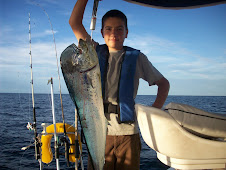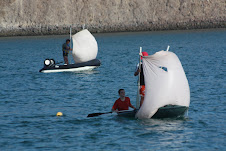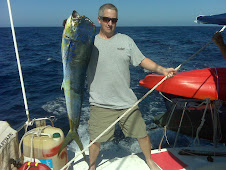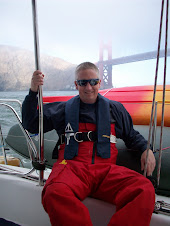We have finally left Banderas Bay, but it took two tries over two days to accomplish it.
Wednesday morning found us visiting with family friends Gale and Dee Flake who happened to be vacationing in Puerto Vallarta. After saying our goodbyes, we motored out of the PV harbor around noon, headed to Yelapa, a small village on the south side of Banderas Bay. Our plan was to anchor there for the night, and then get an early start on rounding Cabo Corientes, the souther lip of Banderas Bay. Cabo Corientes is known to be difficult to navigate around. This headland funnels wind and current. It is best to try to round it in the early morning hours, since you are more likely to find calm seas and gentle winds. Remember that Banderas Bay is huge, about 20 miles wide and 20 miles deep, so being at Yelapa would bring us much closer to Cabo Corientes.
At noon, as we left PV it began lightly raining. Over the next hour as we headed to Yelapa, it became apparent that there was a storm quickly forming over Cabo Corientes, and that we were headed right into it. Lightning began lighting up the gathering dark clouds and the rain became a torrent. Swells quickly grew to five feet with white caps and the wind increased to 28 knots. We prepared for a possible lightning strike by placing our hand held electronics and computers in the oven (I don't know if it really works, but that's what we have been told.) Three miles off of Yelapa, it became clear that it would not provide any shelter in the current wind and swell direction, so we changed direction and headed 12 miles back to the La Cruz anchorage on the north side of Banderas Bay. La Cruz was the lightest spot on the horizon, a lighter gray against the menacing dark clouds. It's ironic how happy we were to drop anchor in La Cruz just at sunset, since we had been so happy to leave the memories of the Weather Bomb just the day before.
Wednesday night in La Cruz, we listened to the Southbound Net on the SSB to hear Don Anderson's weather report for the following day. He reported mild conditions for our area, so we decided to head out the following morning. At 4:30 am we were up, raising the anchor trying to get to Cabo Corientes by morning.
We were nearing Cabo Corientes by 10 am, but it didn't seem to matter that it was still morning. Five miles from the lighthouse, the wind began to grow from the south. We were beating into it. There wasn't much to worry about, it was just a fun day crashing into the waves. We were in the company of 3rd Day, with another two boats a few miles ahead of us, and one a few miles behind. Soon the waves had white caps and the winds were a steady 25 knots, with some gusts to over 30. Waves began breaking over our bow, sending green water over the cabin roof and drenching us in the cockpit. Never seen that before, not even in the Weather Bomb! Jack loved the excitement of the circus ride and took a long turn at the helm, to better enjoy it.
Our speed dropped to 2 knots as we pounded into the wind and waves, with a strong current working against us, too. We began talking with 3rd Day about options. The next closest anchorage was Ipala, and the two lead boats were on their way there. When they reached Ipala, they reported that the anchorage was untenable and they were going on to the next anchorage over 40 miles away.
What to do? Over several conversations, we weighed the options with 3rd Day - turn back so we were running with the wind and get to Yelapa, keep going to the next anchorage, or check out Ipala. 3rd Day was making 1 to 2 knots; we were doing 3 to 4 knots since we had pushed our engines up even higher. It would take forever to get anywhere against the wind and current, even though the wind was now slackening to 15 knots.
About this time we began noticing that storm clouds were gathering north of us in Banderas Bay. This storm looked even bigger than the one we had run from the day before. We weren't about to turn around and head into it. 3rd Day decided to head on to the next anchorage, but Patrick wanted to see Ipala for himself. In 1 1/2 hours, we reached Ipala. The entire way, we watched the storm clouds advance against the wind, getting slowly closer to us. I have never seen storm clouds travel against the wind like I have here. It just shouldn't happen!
We were bummed when we got to Ipala. It is a tiny impression in the coast, offering little shelter and little room. Making it more challenging, local fishermen have placed fish pens through the center of the cove and there is a known submerged pinnacle rock on one side of the cove. One boat was already anchored as we approached. Patrick was determined to anchor here since we were tired from the last two days. Patrick can be very determined. It took five passes through the anchorage to note all the hazards and three attempts to set anchor before we were anchored safely far enough away from the fish pens and the boat, yet still close as could be to the sheltering land.
As we were trying to set the anchor the first time, the wind suddenly changed direction as the storm overtook us. Suddenly the wind kicked up and rain began pouring down. Thankfully the wind was now coming from the direction of the land, so the anchorage provided some protection. Anchoring took almost 40 minutes to complete, unlike the usual 15. We anchored in 40 feet on the outside edge of the anchorage, in the ocean swell. While we were anchoring 3rd Day hailed us and we told them that Ipala was indeed a bad anchorage, but we were staying. Little else could be communicated with 3rd Day since there seemed to be radio problems.
Other boats began showing up in Ipala, seeking shelter from the storm. Everyone was anchoring deep on the outside edge of the anchorage, just trying to get a toe in the door. I now truly empathize with the saying "Any port in a storm." Over the radio we heard the worried calls of the two boats who had left Ipala earlier. They had been overtaken by the squall and were reporting cyclonic winds to 40+ knots. 3rd Day and other boats were out in the squall, too. We tried repeatedly to hail 3rd Day, but could not raise them. Later we learned their mainsail had come apart at some seams while they were trying to lower it in the squall's strong winds. However, they made it safely to an anchorage 60 miles south by daybreak.
The next morning, we woke to beautiful sunny blue skies. We pulled anchor and headed south enjoying warm sun, light winds, and a glorious day like we haven't seen in a month. Go figure!
5 years ago
















One of the joys of cruising? It's experiences like the your from La Cruz to Ipala that make all the other time so sweet! Great adventure and great reading. Good to hear you're all still out there enjoying life. Pete n Kathie, S/V Citla
ReplyDelete